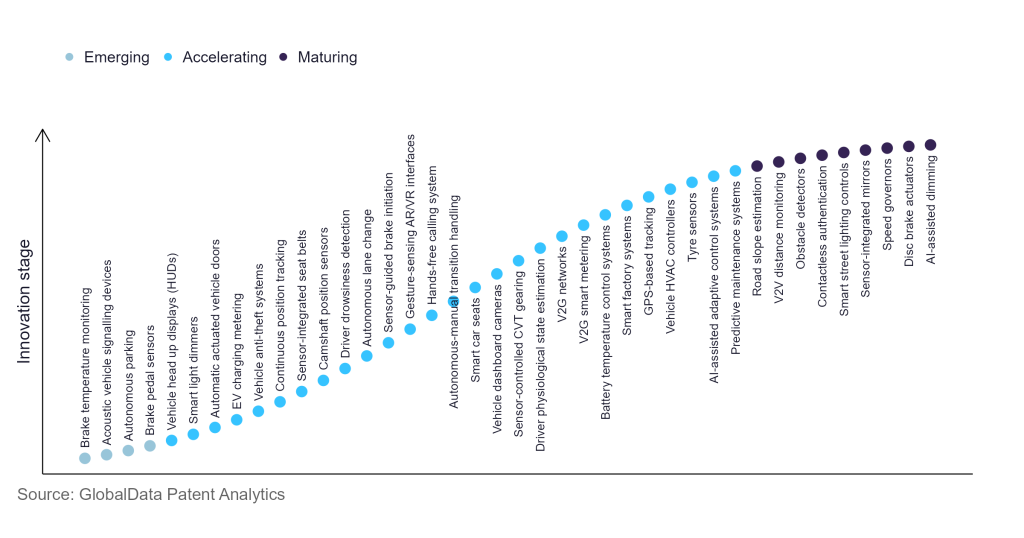The automotive industry continues to be a hotbed of innovation, with activity driven by the need for enhanced driving experience, fuel efficiency, and engine performance, and growing importance of technologies such as electrification, sensors, connected and autonomous vehicles. In the last three years alone, there have been over 1.2 million patents filed and granted in the automotive industry, according to GlobalData’s report on Internet of Things in Automotive: Autonomous-manual transition handling. Buy the report here.
However, not all innovations are equal and nor do they follow a constant upward trend. Instead, their evolution takes the form of an S-shaped curve that reflects their typical lifecycle from early emergence to accelerating adoption, before finally stabilising and reaching maturity.
Identifying where a particular innovation is on this journey, especially those that are in the emerging and accelerating stages, is essential for understanding their current level of adoption and the likely future trajectory and impact they will have.
290+ innovations will shape the automotive industry
According to GlobalData’s Technology Foresights, which plots the S-curve for the automotive industry using innovation intensity models built on over 619,000 patents, there are 290+ innovation areas that will shape the future of the industry.
Within the emerging innovation stage, smart car seats, tyre sensors, and predictive maintenance systems are disruptive technologies that are in the early stages of application and should be tracked closely. Acoustic vehicle signalling devices, brake temperature monitoring, and autonomous parking are some of the accelerating innovation areas, where adoption has been steadily increasing. Among maturing innovation areas are disc brake actuators and AI-assisted dimming, which are now well established in the industry.
Innovation S-curve for IoT in the automotive industry

Autonomous-manual transition handling is a key innovation area in IoT
A vehicle's autonomous-manual transition is carried out by the autonomous driving electronic control unit (AD-ECU) domain controller based on the analysis of a repository of environmental data gathered by the vehicle’s cameras, radar, and other sensors.
GlobalData’s analysis also uncovers the companies at the forefront of each innovation area and assesses the potential reach and impact of their patenting activity across different applications and geographies. According to GlobalData, there are 100+ companies, spanning technology vendors, established automotive companies, and up-and-coming start-ups engaged in the development and application of autonomous-manual transition handling.
Key players in autonomous-manual transition handling – a disruptive innovation in the automotive industry
‘Application diversity’ measures the number of different applications identified for each relevant patent and broadly splits companies into either ‘niche’ or ‘diversified’ innovators.
‘Geographic reach’ refers to the number of different countries each relevant patent is registered in and reflects the breadth of geographic application intended, ranging from ‘global’ to ‘local’.
Patent volumes related to autonomous-manual transition handling
Source: GlobalData Patent Analytics
Toyota is one of the top companies filing patents in autonomous manual transmission in IoT innovation regulation. The latest innovation from Toyota is the newly launched 6-speed manual transmission (6MT), which is one of the world’s smallest transmissions, and its small size contributes to improved fuel efficiency. Honda and Ford are the other significant automotive companies filing patents in this area.
To further understand how IoT is disrupting the automotive industry, access GlobalData’s latest thematic research report on Internet of Things (IoT) in Automotive.
Data Insights
From

The gold standard of business intelligence.
Blending expert knowledge with cutting-edge technology, GlobalData’s unrivalled proprietary data will enable you to decode what’s happening in your market. You can make better informed decisions and gain a future-proof advantage over your competitors.



